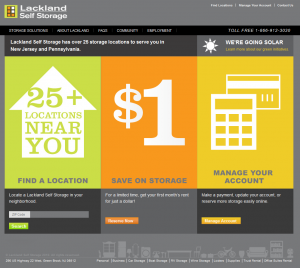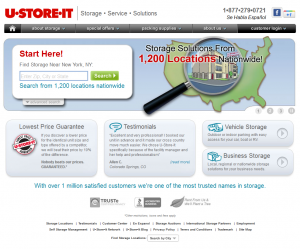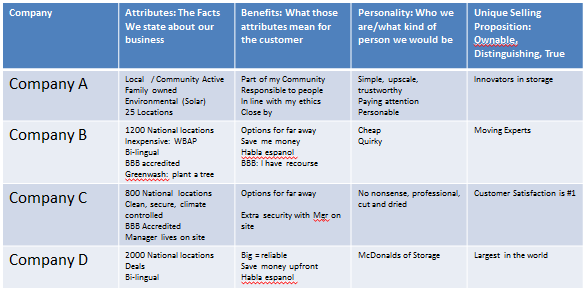What is a brand?
A brand is a distinct message to your consumer that tells them who you are, what you stand for, and how you differ from your competitors. That brand message is conveyed in many ways – by images, color, language, and by the customer experience.
There are many different pieces of creating a cohesive brand, below we will describe some key pieces:
Brand Promise
If you have ever flown a ‘friendly’ airline or tried to do business with a ‘friendly’ back, but found the service not friendly at all, you’ve experienced a broken brand promise.
Your brand promise sums up what the customer should expect from your company.
Your brand promise must be true or you will lose the customer’s trust. If you don’t train your staff to be friendly and accommodating, don’t tell the customer to expect it. Promise them anything else — the lowest price, a guaranteed price, a free roll of tape. But for goodness sake, if you can’t guarantee it, don’t promise it.
Benefits vs. Features
One of the most common mistakes we see in marketing is that the terms benefits and features are often used interchangeably. It is important to know that your Company has a set of benefits AND a set of features.
Your features are the facts about you; the number of units, the convenient location, the climate control, the state of the art security.
Your benefits are what those features mean to the customer; a range of choices, easy drop-by access, storage for fine furniture, peace of mind.
Brand Personality
Human beings are emotional. We like a story. We buy from companies that share our values. Your Brand Personality embodies who your company would be if it were a person. Would you be the quiet, reliable guy? The life of the party? The charity volunteer? Every company has a personality, and to make your brand stand out from your competitors, especially in a commodity business like self-storage, brand personality is crucial to attracting customers and building trust.
Your brand personality comes through in the language you use in your ads and website, the images and colors, and the tone and feel of the design.
Positioning
Positioning is the way to try to create an identity of your brand in the eyes of your target market. It is important to position in order to get the customer to perceive your brand a certain way.
Self Storage is one of the toughest industries to build a distinctive brand in. Competition is everywhere, and the messages easily get muddled. Real distinctions –like concierge service – can be expensive to implement, tough to train, and difficult to deliver consistently.
In self-storage marketing, a successful brand image is always based in truth. If you’re a low-budget solution, present yourself as such; if you mislead a potential customer with promises you can’t fulfill you waste her time and create distrust.
Your Brand Message
A successful brand message is distinct. Consumers are trying to make a decision between one place and another; be as specific as you can be about why you are different/better/right for them.
It’s tempting to try to be ‘all things to all people’ but in the end, you want the customers who are a good fit, because a satisfied customer costs less to service and is more likely to stay with you and recommend you to others.
How do you start marketing your storage brand?
1) Do a competitive comparison.
Think like a consumer and ‘shop’ the different websites and sources that your consumer will look at. What messages are they sending? How do they do it?
This company uses simple graphics and sophisticated colors. This makes them look upscale and attuned to a local community. The customer will expect top-shelf service.
This company uses an out of the box layout and generic imagery. This makes them look less expensive and more cookie-cutter. The customer won’t expect too many frills.
2) To tease out the distinctions in your area, chart yourself and your competitors as follows:
By the factual attributes of each company
The benefits of those attribute
The personality of each company
The unique selling proposition
For example:
3) Next, do a Competitive SWOT. This is a sharper tool than the classic SWOT which looks at your Strengths, Weaknesses, Opportunities, and Threats.
A Competitive SWOT looks at these same characteristics in comparison to your competitors;
- Competitive Advantage:
What do you have that they DON’T have?- Are you cleaner? Better trained? Newer?
- Vulnerabilities:
What do they have that YOU don’t have?- More locations? Lower price?
- Eminent Risks:
What’s happening in the market?- Are you out-advertised? New competitors coming in?
- Must-Win Battles:
What do you HAVE to win?- If you’re not the biggest, can you be the most personal?
- If you can’t be the lowest price, can you rate lock?
- Can you be the most secure? The cleanest?
These brand exercises aren’t new, but they can help your company get a clear picture of itself and communicate that image to every employee and every potential customer.
To conclude, remember this when marketing your self-storage brand:
That not every customer buys for the same reason.
Some customers will pay more if it means extra security, or a more convenient location.
Some customers appreciate personal attention and a well-trained staff.
Some customers will pay extra for an additional cleaning service, or convenience like shelving.
So the clearer and more consistent you can be about YOUR specific advantages as a storage company, the quicker you’ll find the best customers for you.



